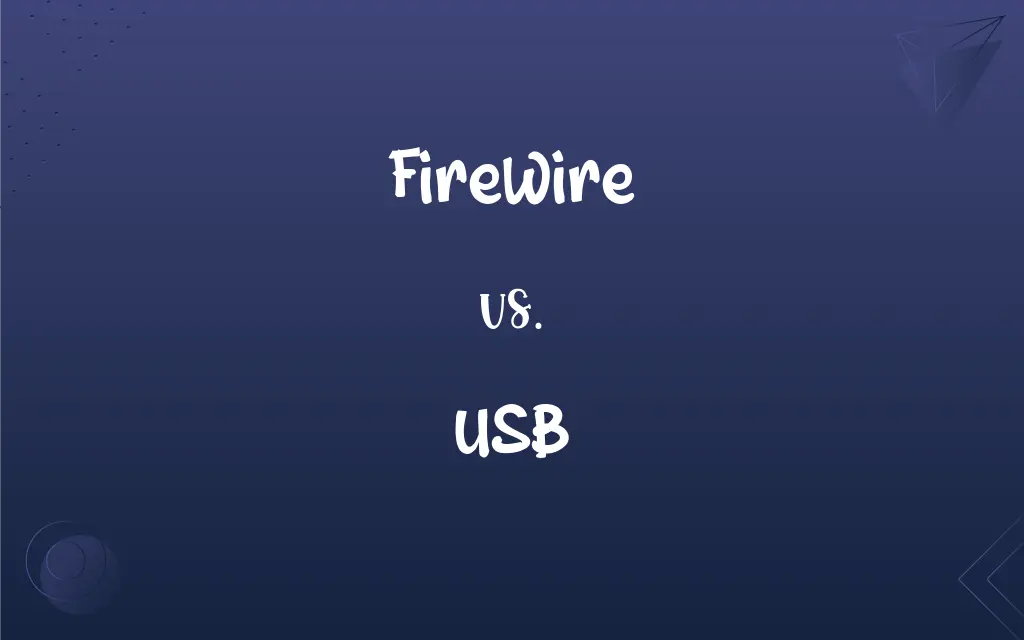FireWire vs. USB: What's the Difference?
Edited by Aimie Carlson || By Janet White || Published on March 3, 2024
FireWire is a high-speed interface for multimedia and data storage devices, while USB is a universal interface for devices ranging from keyboards to storage.

Key Differences
FireWire, developed by Apple, is designed for high-speed data transfer, particularly for multimedia applications. USB, on the other hand, was developed by a consortium of companies led by Intel to standardize the connection of peripherals to personal computers. Both technologies serve the purpose of data transfer and device connectivity but originate from different developmental philosophies and intended uses.
FireWire is known for its high data transfer rates, especially beneficial for video and audio applications, offering speeds up to 800 Mbps in its IEEE 1394b version. USB has evolved from its initial 1.1 version with speeds up to 12 Mbps to USB 3.0 and beyond, reaching speeds over 5 Gbps. This evolution reflects the increasing demand for faster data transfer rates across a broad range of devices.
FireWire supports daisy-chaining of devices, allowing multiple devices to be connected in a series without the need for a hub. USB typically requires a hub for multiple devices, although it has become the standard for charging and powering a wide variety of devices. The differences in connectivity and power delivery highlight the distinct design goals and user experiences envisioned by FireWire and USB developers.
FireWire has seen significant adoption in professional audio and video production due to its speed and reliability for streaming data. USB, with its universal design, has become the dominant interface for computer peripherals, including storage devices, keyboards, mice, and more. The widespread adoption of USB reflects its versatility and ease of use for both consumers and manufacturers.
FireWire has become less common in consumer electronics, with USB and other interfaces like Thunderbolt taking precedence due to their broader support and higher speeds. USB continues to evolve, with newer versions offering increased data transfer rates, enhanced power delivery, and improved connectivity options, ensuring its place as a cornerstone of modern device connectivity.
ADVERTISEMENT
Comparison Chart
Speed
Up to 800 Mbps (IEEE 1394b)
Up to 5 Gbps (USB 3.0) and beyond
Connectivity
Supports daisy-chaining
Requires a hub for multiple devices
Power Delivery
Provides power to connected devices
Widely used for charging devices
Primary Use
Multimedia and professional audio/video
Broad range of peripherals and devices
Adoption
Preferred in professional AV fields
Universal standard in consumer electronics
ADVERTISEMENT
FireWire and USB Definitions
FireWire
A high-speed interface for data transfer between devices.
The video editor connected the external hard drive via FireWire for faster data access.
USB
Comes in various versions with increasing data rates.
The USB 3.0 flash drive offers much faster data speeds than older versions.
FireWire
Provides power through the connection to devices.
The FireWire connection powers the external disk without needing an additional power supply.
USB
A universal serial bus for connecting peripherals to a computer.
She plugged the keyboard into the USB port on her laptop.
FireWire
Supports multimedia applications with minimal latency.
FireWire's low latency is perfect for real-time audio recording.
USB
Supports data transfer and power supply simultaneously.
Charging the phone through USB also allows for file transfers.
FireWire
Allows daisy-chaining of multiple devices.
He daisy-chained the audio interface to the external hard drive using FireWire.
USB
Widely used for a range of devices beyond computers.
The USB charger can power devices from smartphones to e-readers.
FireWire
Developed by Apple and also known as IEEE 1394.
My camcorder uses a FireWire, or IEEE 1394, port for transferring footage.
USB
Features plug-and-play functionality for ease of use.
Connecting the printer via USB was simple, thanks to plug-and-play.
FireWire
A high-speed digital link standard covered by the IEEE 1394-1995 standard.
USB
A serial bus standard used for transferring data to and from digital devices. USB devices such as mice and flash drives are often powered by their USB connection.
FireWire
A system of wires or tubes designed to detect fire and trigger automatic fire-extinguishers in an aircraft engine compartment for example.
FAQs
Is FireWire still used today?
Its use has declined with the advent of USB 3.0 and Thunderbolt, but it remains in some professional AV applications.
What versions of USB are there?
Key versions include USB 1.1, 2.0, 3.0, 3.1, 3.2, and USB4, each with increased data transfer rates.
What is FireWire?
A high-speed interface primarily used for audio and video applications.
How fast is FireWire compared to USB?
FireWire (800 Mbps) can be faster than USB 2.0 (480 Mbps) but is surpassed by USB 3.0 and later.
What's the most common use of USB?
Connecting a wide range of peripherals to computers and charging devices.
Can I connect a USB device to a FireWire port?
Not directly; they use different protocols and connectors, requiring an adapter.
Does FireWire support daisy-chaining?
Yes, it allows for connecting multiple devices in series without a hub.
Is FireWire exclusive to Apple?
Initially developed by Apple, but it was adopted by other manufacturers as well.
Are FireWire cables different from USB cables?
Yes, they have different connectors and are used for different interfaces.
What does USB stand for?
Universal Serial Bus, a standard for computer connectivity.
Can FireWire power devices like USB?
Yes, FireWire can also supply power to connected devices.
Can USB charge devices faster than FireWire?
Yes, especially with USB Power Delivery (USB PD) in newer versions.
Can I use a USB device with a FireWire port using an adapter?
Yes, but performance and compatibility may vary.
How does USB 3.0 improve over its predecessors?
It significantly increases data transfer rates and power delivery capabilities.
How do I know if my device needs FireWire or USB?
Check the device's specifications or manual for its required interface.
What devices typically use FireWire?
Professional video cameras, audio interfaces, and older external hard drives.
Which is more widely adopted, FireWire or USB?
USB, due to its universal compatibility and support across many devices.
Why is USB more popular than FireWire?
USB's broad compatibility and support make it more versatile for general use.
What's the future of FireWire and USB?
USB continues to evolve (e.g., USB4), while FireWire has become niche.
Do all computers have FireWire ports?
No, many newer computers do not include FireWire ports.
About Author
Written by
Janet WhiteJanet White has been an esteemed writer and blogger for Difference Wiki. Holding a Master's degree in Science and Medical Journalism from the prestigious Boston University, she has consistently demonstrated her expertise and passion for her field. When she's not immersed in her work, Janet relishes her time exercising, delving into a good book, and cherishing moments with friends and family.
Edited by
Aimie CarlsonAimie Carlson, holding a master's degree in English literature, is a fervent English language enthusiast. She lends her writing talents to Difference Wiki, a prominent website that specializes in comparisons, offering readers insightful analyses that both captivate and inform.






































































